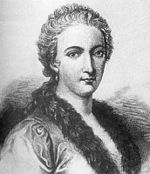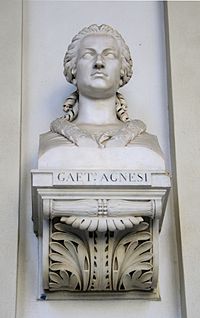- Maria Gaetana Agnesi
-
Maria Gaetana Agnesi 
Born May 16, 1718 Died January 9, 1799 (aged 80) Residence Italy Nationality Italy Fields Mathematics Notes
oldest of 21 childrenMaria Gaetana Agnesi (May 16, 1718 – January 9, 1799) was an Italian linguist, mathematician, and philosopher. Agnesi ((Italian pronunciation: [a.ˈɲe.zi]; the "gn" digraph is pronounced with the palatal nasal /ɲ/) is credited with writing the first book discussing both differential and integral calculus. She was an honorary member of the faculty at the University of Bologna. According to Dirk Jan Struik, Agnesi is "the first important woman mathematician since Hypatia (fifth century A.D.)".
Her sister was Maria Teresa Agnesi Pinottini, a pianist and composer.
Contents
Early life
Maria Gaetana Agnesi was born in Milan on May 16, 1718, to a wealthy and literate family. [1][2][3] Her father desired to elevate his family into the Milanese nobility. In order to achieve his goal, he had married in 1717 Anna Fortunata Brivio. Her mother's death provided her the excuse to retire from public life. She took over management of the household.
Having been born in Milan, Maria was recognized as a child prodigy very early; she could speak both Italian and French at five years of age. By her thirteenth birthday she had acquired Greek, Hebrew, Spanish, German, Latin, and was referred to as the "Walking Polyglot". She even educated her younger brothers. When she was 9 years old, she composed and delivered an hour-long speech in Latin to some of the most distinguished intellectuals of the day. The subject was women's right to be educated. When she was fifteen, her father began to regularly gather in his house a circle of the most learned men in Bologna, before whom she read and maintained a series of theses on the most abstruse philosophical questions. Records of these meetings are given in Charles de Brosses' Lettres sur l'Italie and in the Propositiones Philosophicae, which her father had published in 1738. Maria was very shy in nature and did not like these meetings. Although her father refused to grant this wish of joining a convent, he agreed to let her live from that time on in an almost conventual semi-retirement, avoiding all interactions with society and devoting herself entirely to the study of mathematics. During that time, Maria studied both differential and integral calculus. Her father, Pietro Agnesi, also married twice more after Maria's mother died, so that Maria Agnesi ended up the oldest of 21 children. In addition to her performances and lessons, her responsibility was to teach her siblings. This task kept her from her own goal of entering a convent. Fellow philosophers thought she was extremely beautiful and her family was recognized as one of the wealthiest in Milan.
Contributions to mathematics
Instituzioni analitiche
The most valuable result of her labours was the Instituzioni analitiche ad uso della gioventù italiana, a work of great merit, which was published at Milan in 1748 and "was regarded as the best introduction extant to the works of Euler." [4] The first volume treats of the analysis of finite quantities and the second of the analysis of infinitesimals. A French translation of the second volume by P. T. d'Antelmy, with additions by Charles Bossut (1730–1814), appeared at Paris in 1775; and an English translation of the whole work by John Colson (1680–1760), the Lucasian Professor of Mathematics at Cambridge, "inspected" by John Hellins, was published in 1801 at the expense of Baron Maseres.
Witch of Agnesi
The Instituzioni analitiche..., among other things, discussed a curve earlier studied and constructed by Pierre de Fermat and Guido Grandi. Grandi called the curve versoria in Latin and suggested the term versiera for Italian, [5] possibly as a pun: [6] 'versoria' is a nautical term , "sheet", while versiera/aversiera is "she-devil", "witch", from Latin Adversarius, an alias for "devil" (Adversary of God). For whatever reasons, after translations and publications of the Instituzioni analitiche... the curve has become known as the "Witch of Agnesi".
Other
Madame Agnesi also wrote a commentary on the Traité analytique des sections coniques du Marquis de l'Hôpital, which, though highly praised by those who saw it in manuscript, was never published. [7]
Later life
In 1750, on the illness of her father, she was appointed by Pope Benedict XIV to the chair of mathematics and natural philosophy and physics at Bologna. She was the first woman to be appointed professor at a university. After the death of her father in 1752 she carried out a long-cherished purpose by giving herself to the study of theology, and especially of the Fathers and devoted herself to the poor, homeless, and sick. After holding for some years the office of directress of the Hospice Trivulzio for Blue Nuns at Milan, she herself joined the sisterhood, and in this austere order ended her days, though the terms of her death are unknown.
Remembrance
- Witch of Agnesi, a curve
- A crater on Venus [8]
- Asteroid 16765 Agnesi (1996)
References
 This article incorporates text from a publication now in the public domain: Chisholm, Hugh, ed (1911). Encyclopædia Britannica (11th ed.). Cambridge University Press.
This article incorporates text from a publication now in the public domain: Chisholm, Hugh, ed (1911). Encyclopædia Britannica (11th ed.). Cambridge University Press.
- ^
 "Maria Gaetana Agnesi". Catholic Encyclopedia. New York: Robert Appleton Company. 1913.
"Maria Gaetana Agnesi". Catholic Encyclopedia. New York: Robert Appleton Company. 1913. - ^ http://www.agnesscott.edu/Lriddle/WOMEN/agnesi.htm
- ^ http://press.princeton.edu/books/maor/sidebar_f.pdf
- ^ [1]
- ^ C. Truesdell, "Correction and Additions for 'Maria Gaetana Agnesi'", Archive for History of Exact Science 43 (1991), 385-386. doi:10.1007/BF00374764
- Per Grandi: "...nata da' seni versi, che da me suole chiamarsi la Versiera in latino pero Versoria..."
- ^ S.M.Stigler, "Cauchy and the witch of Agnesi: An historical note on the Cauchy distribution", Biometrika, 1974, vol. 61, no.2 p. 375-380
- ^ Encyclopedia Britannica, 1911, p. 378
- ^ Atlas of Venus, by Peter John Cattermole, Patrick Moore, 1997, ISBN 0521496527, p. 112
- Larson, Ron; Hostetler, Robert P.; and Edwards, Bruce H. (2003). Calculus of a Single Variable: Early Transcendental Functions (3rd edition). Houghton Mifflin Company. ISBN 0-618-22307-X.
- "Maria Gaetana Agnesi", Biographies of Women Mathematicians, Agnes Scott College
- Mathematics History archive entry for Maria Gaetana Agnesi at the University of Andrews, Scotland
- EUROPEAN MATHEMATICAL SOCIETY,NEWSLETTER No. 31,March 1999, S. 18
- D. J. Struik, editor, A source book in mathematics, 1200–1800 (Princeton University Press, Princeton, New Jersey, 1986), pp. 178–180. ISBN 0-691-08404-1, ISBN 0-691-02397-2 (pbk).
- Agnes Scott College, Women Mathematicians
- CSULA Instructional Web Server
Further reading
- Kramer, Edna E. (1970). "Agnesi, Maria Gaetana". Dictionary of Scientific Biography. 1. New York: Charles Scribner's Sons. pp. 75–77. ISBN 0684101149.
- Mazzotti, Massimo (2001). "Maria Gaetana Agnesi: Mathematics and the making of the Catholic Enlightenment." Isis. v. 92, n. 4: pp. 657–683.
- Mazzotti, Massimo (2007). The world of Maria Gaetana Agnesi, mathematician of God. Baltimore: Johns Hopkins University Press.
External links
Categories:- 1718 births
- 1799 deaths
- 18th-century Italian mathematicians
- Women mathematicians
- Italian linguists
- 18th-century Italian philosophers
- Italian Roman Catholic nuns
- People from Milan
- Roman Catholic philosophers
Wikimedia Foundation. 2010.



